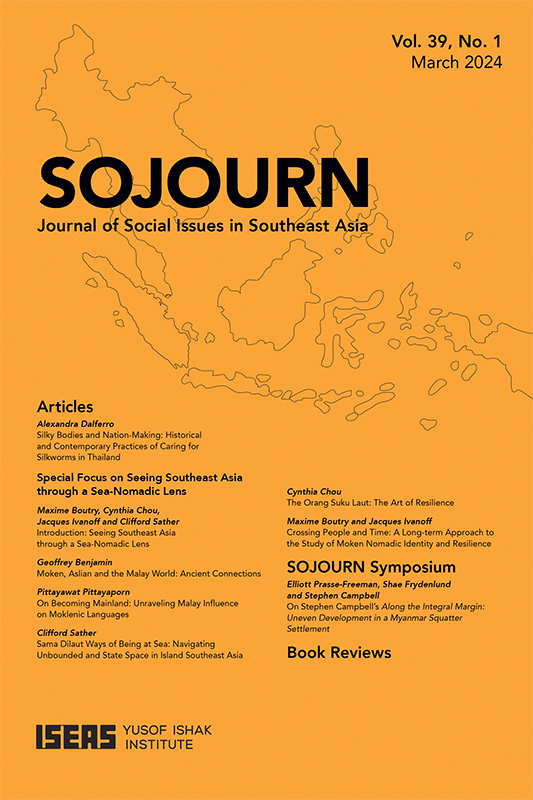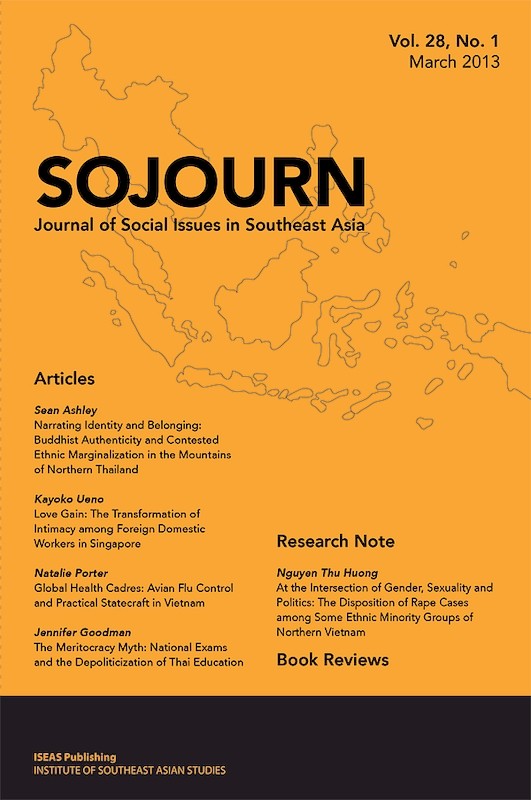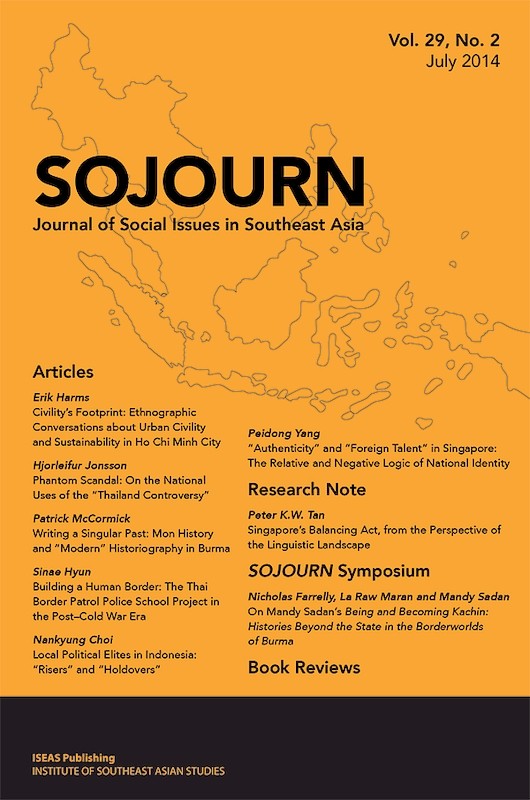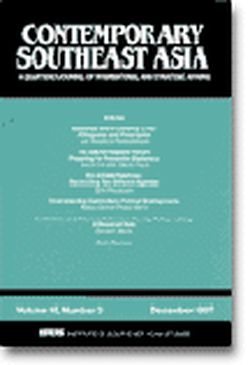SOJOURN: Journal of Social Issues in Southeast Asia Vol. 27/2 (October 2012)
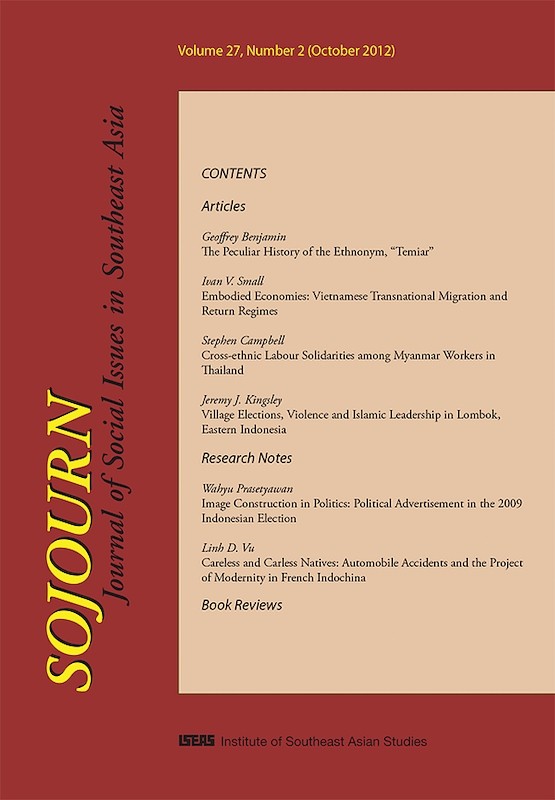
Date of publication:
October 2012
Publisher:
Institute of Southeast Asian Studies
Number of pages:
148
Code:
SJ27/2
Contents
-
SOJOURN: Journal of Social Issues in Southeast Asia Vol. 27/2 (October 2012)
[Whole Publication] -
Preliminary Pages
- ARTICLES
-
The Peculiar History of the Ethnonym "Temiar", by Geoffrey Benjamin, author see abstractThe names for the various Orang Asli populations of Peninsular Malaysia did not begin to achieve any recognizable similarity to current usage until the 1920s. Versions of the ethnonym Temiar, which identifies one of the largest of these populations, were first tentatively reported in the 1880s. At that time the people themselves were barely known to the outside world and were mostly referred to, if at all, by other names. The current spelling and pronunciation of the word Temiar were not fully established until the 1950s, replacing a surprising variety of earlier written forms and pronunciations. A close examination of the latter throws light on the premodern relations holding between the Temiars and other populations. Etymological analysis, involving both Mon-Khmer and Austronesian sources, provides evidence that earlier linguistic situation in the Peninsula was more complex than currently recognized. The Temiar language belongs to the Mon-Khmer stock, but it has long been in contact with one or more Austronesian languages. Investigation suggests two likely etymological sources for the word Temiar, both meaning edge or side, and having forms similar to the Malayo-Polynesian (but non-Malay) *tambir or to Mon-Khmer *tbiar.earlier linguistic situation in the Peninsula was more complex than currently recognized. The Temiar language belongs to the Mon-Khmer stock, but it has long been in contact with one or more Austronesian languages. Investigation suggests two likely etymological sources for the word Temiar, both meaning edge or side, and having forms similar to the Malayo-Polynesian (but non-Malay) *tambir or to Mon-Khmer *tbiar.
-
Embodied Economies: Vietnamese Transnational Migration and Return Regimes, by Ivan V Small, author see abstractThis paper examines differentiated state policies towards two groups of overseas Vietnamese "export" labourers and "returning" overseas Vietnamese - in order to highlight contradictory identity politics. Export labourers literally export their bodies and return money; their absence is the necessary condition for the capital flows they return. Overseas Vietnamese returnees on the other hand voluntarily return their bodies, which in most cases were preceded by remittance flows. Focusing on six case studies, along with an analysis of the evolution and contradictions of state policies towards Vietnamese "export labourers" and "overseas Vietnamese" within the constructed unitary classification of "Vietnamese in foreign countries", this paper highlights the experiences of those living within changing global and state regimes of migration and mobility management. The contradictory notion of homeland return, as differentially articulated by the state and experienced by migrants, offers insight into how broader structures and spectres of global migration are not only ontologically negotiated by migrants themselves, but also illustrates the structural limitations as well as aspirations of the Vietnamese state to manage interstate mobility - both financial and bodily - within broader regimes of global mobility governance.
-
Cross-ethnic Labour Solidarities among Myanmar Workers in Thailand, by Stephen Campbell, author see abstractWith a prominent focus on military conflicts in Myanmar, international media coverage has tended to emphasize the divisiveness of ethnicity in the country. This article, by contrast, looks at interpersonal ties and formations of solidarity amongst an ethnically and religiously diverse body of workers from Myanmar, now residing in Thailand. Drawing on in-depth interviews conducted with Myanmar workers, the central argument of this article is that shared socio-economic grievances have served as salient bases of cohesion and collective action within this multi-ethnic, multi-religious migrant labour context.
-
Village Elections, Violence and Islamic Leadership in Lombok, Eastern Indonesia, by Jeremy J Kingsley, author see abstractIndonesia has undergone a major political transformation over the past decade from authoritarianism to democracy with significant power being delegated to the provincial and local levels. One of the consequences has been the development of rivalries between local elites over the rewards of this decentralization, which can potentially lead to violence. From a conflict management perspective, this article examines one of these localized conflicts that emerged from political machinations on the eastern Indonesian island of Lombok in a village just outside the capital city, Mataram, and the strategies utilized to restore calm. Specifically considered will be the actions of state officials and community leaders, as well as the adat (customary) practices employed and the pivotal role of local Muslim religious leaders, Tuan Guru.
- RESEARCH NOTES
-
Image Construction in Politics: Political Advertisement in the 2009 Indonesian Election, by Wahyu Prasetyawan, author see abstractThis research note analyses the rising importance of political advertisements on television in Indonesian electoral politics. It surveys the ways in which presidential candidates presented themselves to the public during the 2009 elections, as well as the candidates' efforts in cultivating an appealing image for mass consumption. This note concludes that political advertising outperformed print and radio media, and that candidates were likely to construct public images of themselves with traits like nationalism and empathy for the poor in order to attract voters.
-
Careless and Carless Natives: Automobile Accidents and the Project of Modernity in French Indochina, by Linh D Vu, author see abstractExamining a number of reports and poems on car accidents in three periodicals, Thân Chung, Thanh Ngh. Thanh Tân Van, and ?uc Nhà Nam, published around 1930, this research note demonstrates how some Vietnamese intellectuals constructed the notion of car accident victims as the premodern Other, unfit for modern Vietnam. This construction is examined in three sections: (1) profiling of car accident victims as unfit candidates for modernity, (2) the establishment of an arbitrary legality/illegality discourse in these reports, and (3) the impractical advice on how to use the road in a poetry contest hosted by Thanh Ngh. Tin Tân Van.
- BOOK REVIEWS
-
BOOK REVIEW: Neoliberal Morality in Singapore: How Family Policies Make State and Society, by Teo You Yenn, by Gavin W Jones, author
-
BOOK REVIEW: Modern Buddhist Conjunctures in Myanmar: Cultural Narratives, Colonial Legacies, and Civil Society, by Juliane Schober, by Hiroko Kawanami, author

